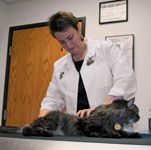Advising clients on treating or euthanizing pets with behavior problems
Our Practitioner Advisory Board weighs in on this critical topic.
WHAT WORKS FOR...
Philip VanVranken, DVM, Dickman Road Veterinary Clinic Battle Creek, Mich.

Dr. Philip VanVranken
Use your head, not your heart
First, take the time to learn what clients' wishes really are. Every single client is different. Sometimes clients are vague about what they want. Often families are divided. (Your staff may even be divided.)
Find out how knowledgeable the clients are about the problem. How long have they been thinking about it? If clients have reached a decision, ask them what their reasons are.
Pet owners are concerned about what their family veterinarian thinks of their intentions. If treatment is a realistic choice, give clients their options. But above all, let clients know that whatever decision they make will be supported 100% by the veterinary staff.
These decisions are always emotional. You need to make sure to use your head, not your heart, when helping these clients. In the end, try to do what's right for the pet and for the family.
WHAT WORKS FOR...
Fred L. Metzger, DVM, DABVP (canine and feline practice), Metzger Animal Hospital, State College, Pa.

Dr. Fred L. Metzger
Fully prepare for the appointment
It's important to learn not to prejudge clients in regard to decisions involving euthanasia. It's impossible to know all the facts that lead clients to this painful decision. To better understand the circumstances, I recommend discussing the situation with clients before they come to the hospital, if possible.
If you feel euthanasia is not warranted, then decline the procedure before the appointment is scheduled. If euthanasia is justified, it's critical to understand the reasons for the decision and share them with your staff before the appointment to avoid conflict and provide the compassion our patients and clients deserve.
WHAT WORKS FOR...
Gary D. Norsworthy, DVM, DABVP (feline practice), Alamo Feline Health Center, San Antonio, Texas

Dr. Gary Norsworthy with technician Emily Boulet.
When housesoiling is the problem
Inappropriate elimination, often called housesoiling, is a complex and common problem. It is the most common behavior problem of cats and one of the main reasons cats are surrendered to shelters. This behavior is usually initiated by a stress-causing situation or a physical disease.
I recommend an aggressive approach to the problem that attempts to resolve stress-causing initiators or diseases that may cause chronic pain or polydipsia and polyuria. If these problems can be diagnosed and relieved, it is much easier to get the cat back to the litter box. However, once inappropriate elimination becomes patterned, a behavioral aspect (compulsion) may develop. In my opinion, after a short time, inappropriate elimination is patterned so deeply in most of these cats that it becomes what would be called in human medicine a form of mental illness. This may be impossible to correct. Ultimately, as Dr. Haug states, the owners can choose to live with the problem, try to rehabilitate the pet to an acceptable level, find a more suitable home for the cat, or euthanize the cat. In addition, I think owners have another option before euthanasia, and that is to make the cat an outdoor-only pet. It is hoped that euthanasia is not the chosen option.
Euthanasia is a decision that needs to be made very carefully, but it is also a decision that may be the best one for certain situations. Regarding feline housesoiling, one has to consider the frequency, the duration (greater than six months means a grave prognosis in my experience), the degree of home damage, the degree of aggravation or tolerance by all family members, the options, and the owner's personal feelings about euthanasia.
WHAT WORKS FOR...
Michael H. Riegger, DVM, DABVP, Northwest Animal Clinic, Hospital and Specialty Practice, Albuquerque, N.M.

Dr. Michael H. Riegger
Get a clear understanding of the situation
One of the toughest issues we face in clinical medicine is coping with the issues surrounding dangerously aggressive dogs.
We have handled more than 250 cases associated with bites, many with legal action. The most emotionally traumatic of these involved the maiming of children's faces.
Our message and plan is a face-to-face visit with the family and dog to develop a clear understanding of the history, situation, environment, triggers, and prognosis.
Then I have a sit-down conference with the family and without the dog to discuss options, risks, strategies, and commitment to a behavior modification plan that includes significant follow-up visits.
One thing I would like to add in regard to Dr. Haug's excellent article is that although dental extractions to address behavior problems are controversial, we have experienced good results with this procedure in about 80% of the patients that would otherwise have been euthanized (because of aggression or destructive problems).
REFERENCES
1. Riegger MH, Guntzelman J. Prevention and amelioration of stress and consequences of interactions between children and dogs. J Am Vet Med Assoc 1990;196 (11):1781-1785.
2. Riegger MH, Guntzelman J. Prevention of aggression in the dog. In Proceedings. 9th Annu ACVIM Forum 1991;279–281.
WHAT WORKS FOR...
Wayne L. Hunthausen, DVM, Animal Behavior Consultations Westwood Animal Hospital, Westwood, Kan.

Dr. Wayne L. Hunthausen
Empathize with the owners
The decision to euthanize is rarely, if ever, an easy one. But it is even more difficult if the pet is healthy, yet poses a considerable danger that cannot easily or dependably be managed.
It is important that the clinician handles these situations with utmost compassion and empathy. Families that feel guilt must be supported so they understand the correctness of the decision and their courage in making it. They need to be told that the caretaker understands the difficulty inherent in choosing to euthanize, but that the consequences of not euthanizing make the decision unavoidable.
WHAT WORKS FOR...
R. Wayne Randolph, VMD, DABVP (canine and feline practice), Countryside Veterinary Hospital, Flemington, N.J.

Dr. R. Wayne Randolph
Facing a complex and variable situation
We first try to accomplish a number of things. We obtain a complete, accurate, and reflective history. Based on the patient's history and the findings from the physical examination and appropriate tests, we rule out concurrent medical problems that might have bearing on the behavioral situation. We try to determine the level of owner frustration, and then consider if this frustration level is consistent with the problem. If we have not resolved the issue by this time, we almost always recommend a consultation with a behaviorist.
After all this, if the problem situation so merits, we will go along with the client's request for euthanasia. We discourage clients from "finding another home" for the problem pet when the behavioral situation is highly problematic and unlikely to be resolved. We explain that such action would merely result in passing this problematic behavioral situation to another (potentially unsuspecting) owner or family.
WHAT WORKS FOR...
Mili Bass, DVM, DABVP (canine and feline practice), Bass Vet Consulting/Animal Acupuncture & Pain Management, Farragut, Tenn.

Dr. Mili Bass
Make the decision guilt-free
Referral to a behaviorist is the first step. But when a client has done all that is possible—with commitment to the prescribed program—without success, the most important part I can play is to assist the client in making a decision to euthanize without guilt. Most veterinarians act as counselors, as well as doctors. A guilt-free decision-making process is my goal.
WHAT WORKS FOR...
Corey Entriken, DVM, Kansas City Veterinary Care, Kansas City, Mo.

Dr. Corey Entriken
Help clients feel confident
These are always difficult decisions, and I try to remember that most clients have been enduring the behavior problem for some time before they make the decision to consult a veterinarian. Some clients may have extenuating circumstances they choose not to share that has led them to seek us out for guidance. Most have developed a genuine bond with even the surliest of pets. The client and I together discuss what may be the best option for the pet. I make sure the client understands there are behavioral specialists we can consult for evaluation and recommendations for treatment options if their lifestyle and motivation are compatible. Many times the knowledge that correction of the problem is possible is all the motivation a client needs to continue trying to help their pet.
However, it's not my place to judge them if their decision is euthanasia. Many do not possess the time, finances, or personality to successfully rehabilitate a pet with a serious behavioral problem. Oftentimes a client just needs to hear it may be more humane to euthanize an animal that is highly destructive or dangerous to people rather than pass the problem off to someone else who could potentially be even less capable of dealing with the problem. Finding an appropriate facility or organization to take these animals can be a daunting task. If we decide the pet is just a poor fit for the owner's lifestyle, then connection with a rescue organization may be more appropriate.
As always, obtaining a thorough history to pinpoint the problem and clearly outlining all the available options is important to allow clients to feel confident that the decision they make is the right one for them and their pets.
WHAT WORKS FOR...
Melissa M. Mckendry, MS, DVM, DABVP (canine and feline practice), Virginia Beach SPCA Pet Care Veterinary Hospital, Virginia Beach, Va.

Dr. Melissa M. Mckendry
Evaluating behavior in relinquished pets
Clients facing the decision to relinquish a pet to (or clients seeking to adopt an animal from) a shelter may find it helpful to investigate how shelters conduct behavioral assessments. Some shelters use peer-reviewed, standardized behavioral assessment protocols.
A systematic behavioral evaluation ideally should be performed on every animal admitted to a shelter or rescue organization, beginning the moment the pet enters the shelter. This evaluation period should continue for several weeks. If the person who relinquished the pet provides its history, it should be included in the animal's record, but it is assumed that information may be incomplete.
The time needed for each animal to settle into a new environment varies; so daily observations by the staff are critical to recognizing the specific needs of individual animals. Older animals or animals exhibiting signs of illness or abnormal stress levels should ideally have a medical evaluation.
The results from behavioral assessments may be considered a helpful guide, but they should not be taken as a 100% accurate prediction of the future behavior of the animal once it is found suitable to be rehomed.
WHAT WORKS FOR...
Robert M. Miller, DVM,Thousand Oaks, Calif.

Dr. Robert M. Miller
The art of giving your opinion
I cannot improve upon Dr. Haug's comprehensive, thoughtful, and appropriate analysis of the subject. All I can offer is how I learned early in my practice career to advise clients about euthanasia when I considered it to be indicated.
A very old man had a cocker spaniel, equally old, with terminal cancer. He brought the old dog in every day for analgesia and supportive therapy. Finally, deciding that all quality of life was gone for the suffering dog, I said, "You know, the kindest thing you can do for him would be to gently put him to sleep."
The old man picked up his dog and said, "I bring him here because you have knowledge I don't have. If I wanted him dead I would have put him in the garage with my car motor running. I'll take him elsewhere. I'll find someone more interested in prolonging life than in ending it."
Properly chastised, I forever changed the way I would suggest euthanasia.
If I deemed it appropriate, I would say, "I know what I would do if he were mine. But he is not mine, and I cannot make that decision."
This is what I learned from countless owners' responses:
- If owners want euthanasia they ask, "What would you do, Doctor?"
- If they do not want euthanasia or are opposed to it, they simply don't answer, or they may say something like, "Do the best you can, Doctor."
I believe that it is incumbent upon us to advise euthanasia if we really believe it to be appropriate, for whatever the reason. But by saying "I know what I'd do if he were mine," we remove the harshness from the decision. It offers the client an option, yet expresses our professional opinion.
WHAT WORKS FOR...
Thomas McCoy, DVM, Harvard Avenue Veterinary Clinic, Tulsa, Okla.

Dr. Thomas McCoy
Develop a realistic plan
Practitioners must prevent their personal biases from leading client expectations or unduly influencing clients' decisions in these often-emotional circumstances. Dr. Haug emphasizes thorough case assessment, including patient signalment and history; client factors, such as the family's feelings and perceptions; environmental factors; and the history of compliance. Our duty is to develop a realistic plan. After considering all aspects, I present therapeutic options based on the specifics of the individual case. It is unfair—and possibly dangerous—to offer therapies that, based on knowledge of the case, cannot be achieved. Recognize that we cannot reform all patients.
WHAT WORKS FOR...
Robin Downing, DVM, Windsor Veterinary Clinic PC, Windsor, Colo.

Dr. Robin Downing
Be candid, but cautiously optimistic
When we are faced with this heartbreaking scenario, we do our best to work with the family to set priorities. Our number one priority is the safety of the people in the family. Then we evaluate the safety of the affected pet and other pets in the household, property destruction, and any escape issues. We try to be direct and honest, but we remain cautiously optimistic as we counsel the entire family and encourage full cooperation among family members. These really are individual, or "n=1," clinical cases, and we try to refer to behaviorists whenever needed.